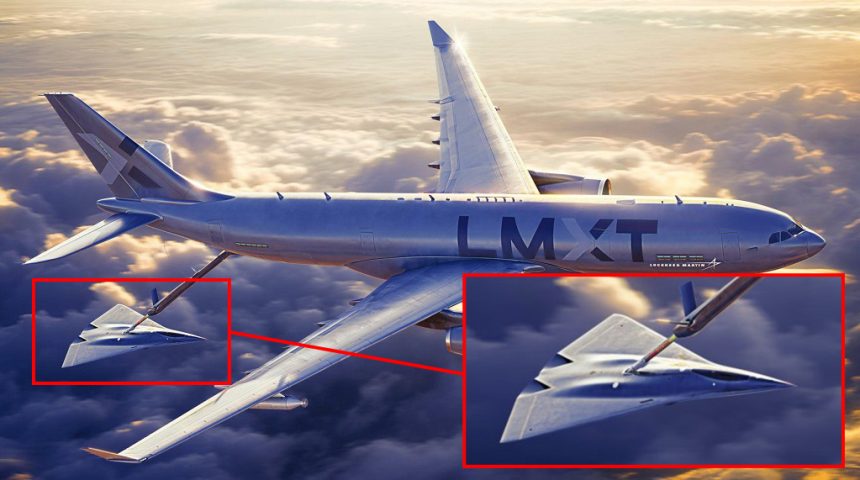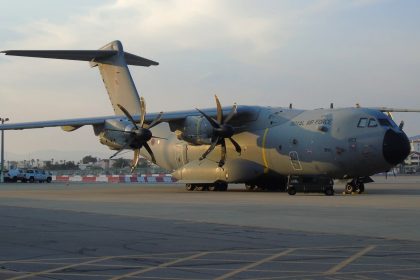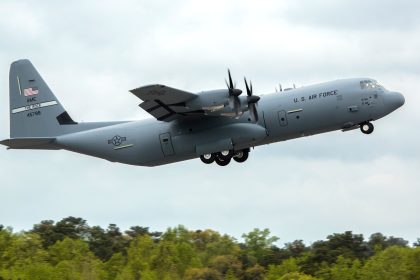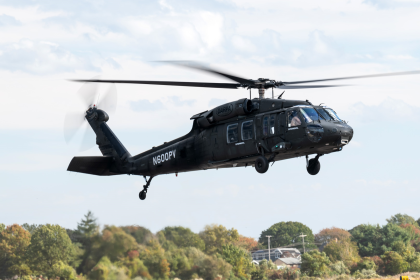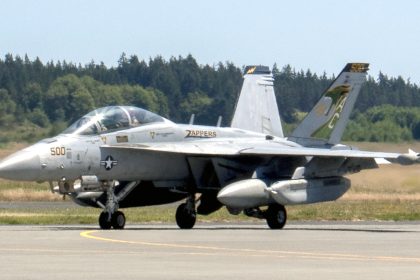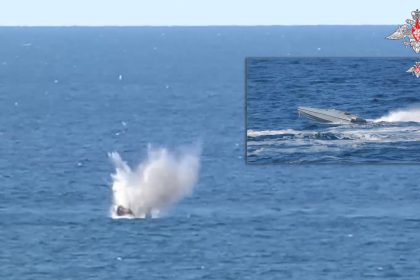The notional design for the Next Generation Air Dominance program was shown during a briefing about the LMXT tanker, which the company is proposing for the KC-Y competition.
Lockheed Martin released new renderings showing a manned sixth-generation fighter aircraft as a notional stand-in design for the U.S. Air Force Next Generation Air Dominance program, or NGAD. The images were included in a media briefing about the company’s proposal for the KC-Y competition, the Airbus A330 MRTT-derived LMXT tanker. Interestingly, the images were released only to the media attending the briefing, but not on the company’s website or social medias.
Previous renderings showed the tanker refueling F-22s and F-35s. Lockheed Martin officials said that this isn’t necessarily what NGAD would look like, without providing further comments. While there are two parallel NGAD programs, one run by the Air Force and the other one by the Navy, this design should be for the former program, since it was shown during an Air Force’s competition briefing.
At a briefing for reporters this morning on its LMXT refueling tanker, Lockheed Martin released two concept art images of LMXT gassing up an NGAD fighter. This isn’t necessarily what NGAD would look like, they said, but an interesting glimpse nevertheless. pic.twitter.com/hgfneG4AL9
— Stephen Loose-eye 🧟🎃 (@StephenLosey) October 25, 2022
The appearance of this 6th-gen design is similar to previous designs released by Lockheed Martin, showing a tailless design (considered ideal to obtain very low observability) with a diamond-shaped wing planform with straight leading and trailing edges. The aircraft features a prominent chine line (much like the F-22 and F-35), tapered almost in a straight line from the wing root to the nose.
The engines are fully contained in the fuselage, with only two bulges denoting their position on the upper fuselage. As many low-observable designs, the exhaust is located on the upper surface of the rear fuselage, shielding almost completely the infrared signature of the two-dimensional diamond-shaped nozzles. The air intakes are not visible, as they are mounted below the fuselage, flush with the joint between wing root and fuselage, as it could be seen in an older frontal rendering of the almost identical design.
The aircraft also shows a long, low-profile cockpit which is flush with the fuselage upper outline. A possible explanation is related to the optionally manned capability, so this cockpit configuration would prefer better aerodynamics for the unmanned flight at the expense of visibility during the manned flight. However, the lack of visibility would be compensated by a system like the F-35’s Distributed Aperture System.
We can’t really argue about the lack visibility during close combat, as an aircraft like this would fight 99% of the time in the Beyond Visual Range arena at standoff ranges. In fact, this was also stated by officials, as it was reported that the final NGAD design may or may not look like a traditional fighter because range, payload and low observability would probably have priority over extreme maneuverability.
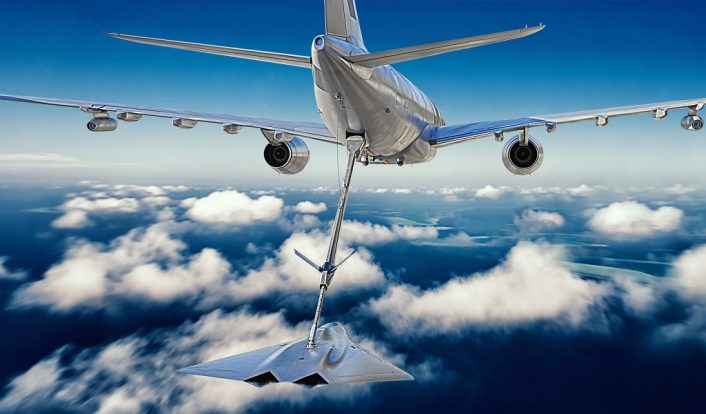
Let’s not forget that the Air Force is considering the possibility of two different variants of the aircraft with different performance, a longer-range aircraft intended for operations in the Indo-Pacific theater and a shorter-range aircraft for the European theater. The one in the renderings could be the short-range variant, as it appears to have a size roughly comparable with the F-22, even if most probably the image is not to scale.
As already mentioned, this isn’t necessarily what NGAD would look like. As a matter of fact, our friends at The War Zone spotted another tailless, delta-wing aircraft in satellite imagery of Area 51 with a different planform than the one seen in these renderings. It is currently unknown if that aircraft is related to the NGAD demonstrator that has been flying in secret at least since 2020, but Groom Lake is, for sure, a prime location to fly from with such a secretive aircraft.
Anyway, it is currently unclear whether a final design for NGAD has been chosen or multiple companies are proposing separate designs for the selection, as Lockheed Martin is just one of the companies involved in the program. Also, Secretary of the Air Force Frank Kendall said that there is still competition within the project, without further explaining.
Another option could be each company being assigned specific components of the design that would later be integrated in a final “joint” design. The regular acquisition process has, in fact, been dropped in favor of hiring companies to carry out separate tasks in order to speed up the whole process and reduce costs.
“The program uses a non-traditional acquisition approach to avoid traditional monolithic program schedules and exorbitant life-cycle sustainment costs”, says an unclassified USAF biennial report for acquisition. “This strategy, called the Digital Century Series approach, creates a realistic business case for industry to adopt commercial best practises for key design activities – before a part is even manufactured.”
The Air Force has said that NGAD will develop four publicly acknowledged technologies, each possibly assigned to a different company, that will end up in the final design: propulsion, unmanned systems, materials and sensors. For propulsion, a large potential Air Force contract under the Next Generation Adaptive Propulsion program (NGAP) has been awarded to Lockheed Martin, together with Boeing and Northrop Grumman, General Electric and Pratt & Whitney.
In particular, General Electric concluded phase one testing of its second XA100 adaptive cycle engine, a 6th-gen fighter engine manufactured as part of the US Air Force’s Adaptive Engine Transition Program (AETP). The engine, the world’s first ever flight-weight, three-stream adaptive cycle engine, is intended to be used both by the F-35 and the future NGAD design and combines key innovations to deliver a generational change in combat propulsion performance.
Another area where the Air Force is putting a lot of effort is the unmanned side of NGAD, which is expected to collect intelligence, provide electronic warfare capabilities and carry additional munitions. Using a definition that the Air Force seems to appreciate a lot lately, the drones that will complement NGAD are being designed to be attritable and to fly in the heat of the fight, while the manned fighters will stay at standoff ranges and “play quarterback”.
Actually, much of the offensive capabilities will be provided by “loyal wingman” drones. As a risk reduction, Kendall said that the US and Australia are “having preliminary discussions” about buying the MQ-28, also known as Boeing Airpower Teaming System, for NGAD’s drone capability. The MQ-28 is being developed to operate as a team with Australian F/A-18s and F-35s, using artificial intelligence to extend the combat capabilities of the manned-unmanned teaming (MUM-T) concept.
The aircraft was also previously pitched for the Skyborg program, initiated by the Air Force Research Laboratory to provide pilots with greater situational awareness and survivability during combat missions. Artificial Intelligence is a big part also in this concept, detecting potential air and ground threats, determine threat proximity, analyze imminent danger, and identify suitable options for striking or evading enemy aircraft, making the decisions based on established rules of engagement set by human pilots. An MQ-28 has currently been transferred in the US for evaluation.
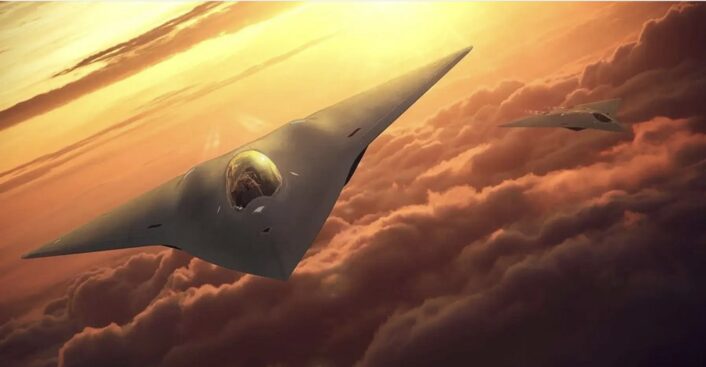
Revising a previous statement that was misunderstood, Kendall said that the NGAD program has not formally entered the engineering, manufacturing and development stage, providing an update on the status during a roundtable at the Air and Space Forces Association’s Air, Space and Cyber conference. The program has not yet gone through the Milestone B review process, which marks the completion of the technology maturation phase and the formal start of the acquisition program, when the service takes its preliminary design and focuses on system integration, manufacturing processes and other details ahead of production.
According to Kendall, the Air Force is still designing NGAD. “The clock really didn’t start in 2015, it’s starting roughly now,” Kendall said. “We think we’ll have capability by the end of the decade.” It has been reported that it typically can take the United States Air Force’s acquisition programs about seven years to reach Initial Operating Capability (IOC) from the beginning of the EMD phase. Air Force acquisition chief Andrew Hunter was more specific, saying that the end of this decade is the service’s goal for “fielding the manned platform” component of NGAD and the drones, which are being referred to as collaborative combat aircraft, are expected to arrive sooner.
Experts however are not so optimistic about this timeline. The cost is also another issue, with the program poised to become the most expensive aircraft program in history. Kendall even admitted that each NGAD fighter could cost “hundreds of millions of dollars” and, when asked if the US can afford it, responded “Can the nation afford not to have air superiority? We have to have air superiority.”
Yet another issue for which experts are concerned is the repercussion of the NGAD program on the F-35 funding. However, the F-35 is funded largely through procurement, while NGAD is funded through research and development, which keeps the two budgets separate and allows the Air Force to keep its target fleet of F-35 intact. Also, NGAD is expected to replace the F-22, which shares the same air dominance role. There are currently around 185 F-22s in the inventory, but they will likely not be replaced in a one-to-one ratio as the Air Force may only buy 100 6th gen. fighter jets.

